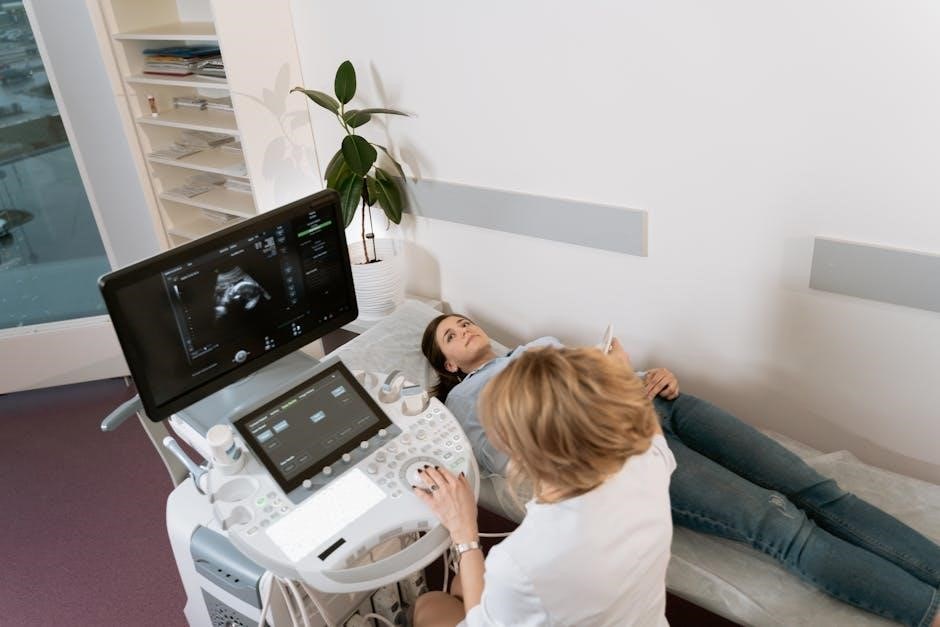The DISC test is a popular behavioral assessment tool used to understand individual personality styles, aiding in personal and professional growth by identifying core behavioral traits.
1.1 What is the DISC Test?
The DISC test is a widely used behavioral assessment tool designed to identify and analyze individual personality styles. It focuses on four primary behavioral traits: Dominance (D), Influence (I), Steadiness (S), and Conscientiousness (C). These traits help determine how individuals interact with their environment and others. The test is often administered through a series of questions that evaluate preferences and tendencies, providing insights into communication styles, decision-making processes, and problem-solving approaches. It is commonly used in professional settings for leadership development, team building, and recruitment to enhance interpersonal relationships and workplace efficiency. The results are typically presented in a detailed report or PDF format for easy interpretation.

1.2 Importance of the DISC Test in Personality Assessment
The DISC test plays a crucial role in personality assessment by providing insights into behavioral tendencies and communication styles. It helps individuals understand their strengths and weaknesses, fostering self-awareness and personal growth. Organizations utilize the test to enhance team dynamics, improve leadership skills, and streamline recruitment processes. By identifying dominant traits, the DISC test enables better decision-making and conflict resolution. Its practical applications make it a valuable tool for both personal and professional development, offering a clear framework for understanding and improving interpersonal interactions in various settings.

History and Development of the DISC Test
The DISC test originated from William Moulton Marston’s theory of behavioral styles, evolving over decades to become a widely used tool for personality and leadership assessments.
2.1 Origins of the DISC Model
The DISC model traces its roots to the work of William Moulton Marston, an American psychologist, who in his 1928 book Emotions of Normal People, introduced the concept of four primary behavioral styles: Dominance, Influence, Steadiness, and Correctness. These styles were later developed into the DISC assessment tool, which became widely used for understanding personality traits and improving interpersonal interactions. The model has since evolved, but its foundation remains tied to Marston’s original theory, which emphasized the importance of self-awareness and behavioral adaptability in personal and professional settings.
2.2 Evolution of the DISC Test Over Time
The DISC test has undergone significant evolution since its inception. Initially developed from William Marston’s theory, it was later refined by researchers like John Cleaver and others to become a standardized assessment tool. Over the years, the test has transitioned from paper-based formats to digital platforms, enhancing accessibility and ease of use. Modern versions incorporate advanced analytics and customizable reports, making it a versatile tool for various applications. Despite these changes, the core principles of the DISC model remain intact, focusing on understanding behavioral styles to improve communication and teamwork.

Core Principles of the DISC Test
The DISC test assesses four primary behavioral styles—Dominance, Influence, Steadiness, and Conscientiousness—providing insights into personality traits to enhance personal and professional effectiveness and communication strategies.
3.1 The Four Behavioral Styles: D, I, S, and C
The DISC test identifies four distinct behavioral styles: Dominance (D), Influence (I), Steadiness (S), and Conscientiousness (C). Each style represents unique traits and tendencies in behavior. Dominance reflects assertiveness and control, while Influence emphasizes communication and enthusiasm. Steadiness is characterized by consistency and reliability, and Conscientiousness focuses on accuracy and analysis. These styles help individuals understand their strengths and weaknesses, enabling personal and professional growth. By recognizing these traits, the DISC test provides a framework for improving communication, leadership, and teamwork, making it a valuable tool for self-awareness and development.

3.2 Understanding Dominance (D)
Dominance (D) in the DISC test represents individuals who are assertive, decisive, and results-oriented. These individuals thrive in leadership roles, often taking charge and setting goals. They value control and action, preferring to focus on the big picture rather than details. People with a high D style are confident and strong-willed but may struggle with patience and delegation. Understanding this style helps individuals recognize their natural leadership tendencies and improve their ability to motivate others and achieve objectives effectively in both personal and professional settings.
3.3 Understanding Influence (I)
Influence (I) in the DISC test refers to individuals who are sociable, enthusiastic, and enjoy interacting with others. These people are natural communicators, often excelling in roles that require building relationships and motivating others. They thrive in dynamic environments and are driven by recognition and positive feedback. While their strength lies in inspiring and connecting with people, they may struggle with conflict or detailed tasks. Understanding the Influence style helps individuals leverage their charisma and improve collaboration, making them valuable assets in team-oriented and customer-focused settings.
3.4 Understanding Steadiness (S)
Steadiness (S) in the DISC test represents individuals who are consistent, reliable, and patient. These people value stability and often prefer structured environments where they can work steadily without sudden changes. They are known for their loyalty and ability to maintain a calm demeanor, even in challenging situations. Steadiness individuals excel in roles requiring attention to detail and long-term focus. However, they may resist change or hesitate to take risks. Understanding Steadiness helps individuals harness their reliability and patience, making them invaluable in roles that require stability and dependability, while also encouraging growth in adaptability and decision-making.
3.5 Understanding Conscientiousness (C)
Conscientiousness (C) in the DISC test refers to individuals who are detail-oriented, analytical, and value accuracy. These people thrive in structured environments and are known for their organizational skills and reliability. They often prioritize quality over speed, ensuring tasks are completed to high standards. C-style individuals may be reserved in social interactions, preferring to focus on tasks rather than people. While their meticulous nature can lead to overanalysis, it also makes them highly dependable. Understanding Conscientiousness helps individuals leverage their strengths in planning and execution while encouraging flexibility and collaboration in team settings.
Applications of the DISC Test
The DISC test is widely used for team building, leadership development, and improving communication. It helps organizations identify strengths, enhance collaboration, and make informed hiring decisions effectively.
4.1 Leadership Development and Team Building
The DISC test is a valuable tool for leadership development, helping leaders understand their behavioral styles and how they impact team dynamics. By identifying strengths and areas for improvement, leaders can adapt their approaches to inspire and motivate their teams more effectively. The test also fosters team building by revealing how different personalities interact, enabling better collaboration and communication. Understanding these dynamics helps leaders address conflicts and create a harmonious work environment. Additionally, the test aids in recruiting the right candidates, ensuring a balanced team with diverse skills and perspectives, which is crucial for organizational success.
4.2 Recruitment and Employee Selection
The DISC test is widely used in recruitment to identify candidates whose behavioral styles align with job requirements. By assessing Dominance, Influence, Steadiness, and Conscientiousness, employers can determine how well a candidate fits a specific role. This tool helps in selecting individuals who not only have the necessary skills but also the right temperament for the team. It reduces turnover by ensuring role-person fit and improves workplace dynamics. Additionally, the test aids in creating balanced teams by highlighting complementary strengths, fostering collaboration, and enhancing overall organizational performance through informed hiring decisions.
4.3 Improving Communication and Interpersonal Relationships
The DISC test enhances communication by helping individuals understand and adapt to different behavioral styles. By recognizing Dominance, Influence, Steadiness, and Conscientiousness traits, people can tailor their interactions to others’ preferences, reducing conflicts and improving collaboration. This tool fosters empathy and active listening, enabling more effective teamwork and stronger relationships. In workplaces, it helps leaders communicate more effectively with their teams, while in personal settings, it strengthens connections by promoting mutual understanding. The DISC test is a valuable resource for building harmonious and productive relationships in both professional and personal contexts.
How to Take the DISC Test
The DISC test is typically completed online, featuring a series of questions assessing behavioral preferences. Responses are analyzed to determine your primary style among D, I, S, and C.
5.1 Step-by-Step Guide to Completing the Test
To take the DISC test, visit a certified platform or use a provided link. Begin by creating an account or entering an access code. Read instructions carefully and start the assessment. Answer a series of questions honestly, selecting responses that best reflect your behaviors. Most tests take 10-15 minutes to complete. Review your answers if time allows, then submit. Results are generated immediately, providing a detailed report on your DISC style. Ensure a quiet environment and genuine responses for accurate outcomes. This process helps identify your behavioral tendencies and offers insights for personal and professional growth.
5;2 Preparing for the Test
Before taking the DISC test, understand its purpose and what it measures. Familiarize yourself with the format by reviewing sample questions or guides. Ensure you have a quiet, distraction-free environment. Gather any necessary materials, such as a pen or access to a computer. Approach the test with honesty, as it requires authentic responses to provide accurate results. Avoid overthinking; choose answers that reflect your natural behaviors. Consider discussing expectations with a facilitator if available. Proper preparation ensures a smooth experience and reliable outcomes, helping you gain meaningful insights into your behavioral style.
5.3 Interpreting Test Results
Interpreting DISC test results involves understanding your behavioral profile, which highlights strengths, tendencies, and areas for improvement. The results are typically presented as a graphical representation of your D, I, S, and C scores. Each score indicates your preference for dominance, influence, steadiness, or conscientiousness. A trained facilitator can help you analyze the results, providing insights into your communication style, decision-making, and conflict resolution approaches. The insights gained can be used to enhance leadership skills, improve teamwork, and personalize development plans. Understanding your results is key to leveraging the test’s benefits for personal and professional growth.

Benefits and Limitations of the DISC Test
The DISC test enhances communication and teamwork by providing insights into behavioral styles. It is user-friendly and cost-effective, making it accessible for various applications. However, it may oversimplify complex personalities and is not a standalone tool for hiring decisions.
6.1 Advantages of Using the DISC Test

The DISC test offers numerous benefits, including enhanced communication, improved teamwork, and personalized insights into behavioral styles. It aids in leadership development by identifying strengths and areas for growth. The test is widely used in recruitment to align roles with candidates’ natural tendencies. Its simplicity and accessibility make it a valuable tool for both personal and professional growth. By understanding individual preferences, the DISC test fosters better collaboration and reduces conflicts. It is also cost-effective and user-friendly, making it a popular choice for organizations and individuals seeking self-awareness and development opportunities.

6.2 Criticisms and Limitations of the Test
The DISC test has faced criticism for its lack of scientific validation and oversimplification of complex personalities. Critics argue it lacks depth in behavioral analysis and may not accurately predict job performance. Some view it as too subjective, as results depend on self-perception. Additionally, the test is not designed for hiring decisions, yet it is often misused for this purpose. Its focus on broad categories can overlook nuanced traits, limiting its utility in detailed psychological assessments. While useful for general insights, it should be complemented with other tools for a comprehensive evaluation.

Real-World Examples and Case Studies
Companies worldwide use the DISC test to enhance team dynamics and leadership. For instance, a tech firm improved communication and productivity by aligning roles with behavioral styles, ensuring better collaboration and employee satisfaction.
7.1 How Companies Use the DISC Test for Team Improvement
Companies utilize the DISC test to identify behavioral styles within teams, fostering improved communication and collaboration. By understanding individual traits, organizations can address conflicts and enhance productivity. For instance, a company might use DISC to tailor team-building activities, ensuring each member’s strengths are leveraged. Leaders also apply DISC insights to delegate tasks effectively, promoting a balanced and harmonious work environment. This approach not only boosts morale but also drives collective success, making DISC a valuable tool for sustainable team growth and development.
7.2 Success Stories from DISC Test Implementation
Many organizations have reported significant improvements after implementing the DISC test. For example, a leading tech firm used DISC to enhance team communication, resulting in a 30% increase in project efficiency. Another company incorporated DISC into its recruitment process, reducing turnover by 25% by aligning roles with candidates’ behavioral styles. Additionally, a global retailer trained its managers using DISC, leading to higher employee satisfaction and improved customer service ratings. These success stories highlight how DISC can drive measurable outcomes, fostering better collaboration and leadership within organizations.
The DISC test remains a valuable tool for understanding behavior, enhancing leadership, and improving teamwork, with its insights continuing to evolve in modern psychological applications.
8.1 Final Thoughts on the DISC Test

The DISC test is a powerful tool for self-awareness and interpersonal effectiveness, offering insights into behavioral styles that enhance leadership, communication, and teamwork. While it has limitations, its adaptability and widespread use make it a valuable resource for personal and professional development. By understanding individual strengths and weaknesses, the DISC test fosters empathy and collaboration, helping individuals and organizations thrive in dynamic environments. Its enduring relevance lies in its ability to bridge personality and performance, making it a cornerstone of modern psychological assessments.
8.2 Future of the DISC Test in Modern Psychology
The DISC test is expected to evolve with advancements in psychology and technology, integrating AI for deeper insights and personalized feedback. Its adaptability to diverse cultures and industries ensures its relevance in a globalized world. As organizations prioritize emotional intelligence and team dynamics, the DISC test will remain a key tool for fostering collaboration and leadership development. Future iterations may combine DISC with other assessments, like TTI, to provide a more comprehensive understanding of behavior and motivation, solidifying its role in modern psychological practices and workplace strategies.
